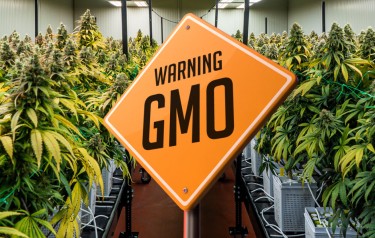
The Rise of GMO Hemp!
There’s a critical difference between traditional breeding of cannabis plants and genetically modifying them through biotechnology. Today, we’ll explore this distinction by examining the latest development in the cannabis industry – the USDA’s approval of a genetically modified (GMO) hemp strain.
Genetic modification involves directly altering the genes of an organism, introducing desirable traits not found in that species. This is different from breeding, which relies on selecting plants with advantageous genes that arise through natural genetic variation and crossbreeding them over multiple generations.
GMOs are already heavily utilized in major agricultural crops like corn, soy, and cotton. Given that industrial hemp falls under the jurisdiction of the U.S. Department of Agriculture (USDA), it’s unsurprising that hemp would follow this trend toward genetic engineering as the industry seeks to optimize traits and increase profits.
In this article, we’ll take a close look at the USDA’s recent approval of a GMO hemp strain called “Badger G” from the University of Wisconsin. This hemp variety has been genetically edited to eliminate the production of THC and CBD – the two most abundant and commercially significant cannabinoids found in cannabis plants. Instead, Badger G has been modified to increase levels of the lesser-known cannabinoid CBG.
By scrutinizing this landmark case of an approved GMO hemp cultivar, we can better understand the potential implications – both positive and negative – that genetic engineering could have on the rapidly evolving hemp industry. Key issues we’ll examine include potential cost savings, regulatory compliance, ethical concerns, and how this differs from traditional cannabis breeding programs.
Badger G is a genetically modified variety of hemp that was recently approved by the U.S. Department of Agriculture (USDA) for cultivation in the United States. Developed by researchers at the University of Wisconsin’s Crop Innovation Center, it represents a pioneering step in the genetic engineering of cannabis plants.
As detailed in the USDA announcement, Badger G has been genetically edited to knock out the expression of the CBDAS gene, which is responsible for producing the cannabinoids CBD and THC. By eliminating this gene, the modified hemp strain does not contain any detectable levels of CBD or THC. Instead, Badger G produces elevated levels of the lesser-known cannabinoid cannabigerol (CBG).
So what problem does a non-THC, non-CBD hemp variety solve? One of the primary challenges facing hemp growers since its federal legalization in 2018 has been maintaining THC levels below the allowable 0.3% limit. Hemp crops testing “hot” over this threshold are considered non-compliant and subject to destruction – a costly error. By removing THC entirely from its genetic makeup, Badger G provides hemp farmers with a bio-engineered solution to ensure legal compliance without this regulatory risk.
Furthermore, Badger G highlights how genetic engineering could enable specialized hemp cultivars tailored for different applications. While the source plant is extremely versatile with uses spanning textiles, food, supplements, biofuels and more, certain traits may be optimized for particular industries. A CBG-rich strain like Badger G could focus on pharmaceutical or nutraceutical markets, while other GMO varieties may enhance fiber quality for textiles, increase seed oil yields, or boost nutrition profiles for animal and human consumption.
This capacity for genetic differentiation supports the notion that hemp is not a one-size-fits-all crop. By harnessing biotechnology, the hemp industry could develop multiple distinct varietals suited for diverse commercial streams – textiles, food and beverage, dietary supplements, industrial materials, livestock feed, and so on. Growers and businesses could strategically select the specific traits and cannabinoid/terpene profiles best aligned with their product goals.
Of course, Badger G represents just an initial foray into genetically engineered cannabis. While targeted for industrial hemp, this development begs the question – when might we see GMO marijuana strains tailored for the adult-use market? breeding programs have already produced specialized cannabis chemovars high in THC, CBD, and lesser-known molecules like THCV and CBG. However, precise gene editing could take this even further, allowing scientists to truly customize cannabinoid and terpene profiles with immense specificity.
Most cannabis industry experts agree that genetically modified marijuana cultivars are an inevitability, despite the current uncertainty surrounding regulations. The FDA has already approved synthetically producing individual cannabinoids like THC and CBD. Given the immense commercial prospects, it seems only a matter of time before biotech firms develop patented GMO cannabis strains optimized for pharmaceutical or recreational markets. So while Badger G may be the first, it likely foreshadows many more genetically engineered varieties to come across the entire cannabis genus.
While both involve altering the genetics of an organism, there are critical differences between selective breeding and genetically modifying (GM) a plant through techniques like gene editing or genetic engineering. Selective breeding relies solely on natural methods to produce desired traits, whereas genetic modification directly manipulates an organism’s genes using biotechnology.
Selective breeding takes advantage of the natural genetic diversity present within a plant species. Breeders select parental plants with specific favorable traits and cross-pollinate them over successive generations. By consistently choosing offspring with the most desirable characteristics, conventional breeding programs can gradually concentrate useful genes and weed out unfavorable ones. However, this is limited to the genetic variation already present in that species’ gene pool.
In contrast, genetic modification allows plant scientists to directly add, remove, or edit specific genes from completely different organisms – capabilities far beyond what selective breeding can achieve through natural processes. Common GM techniques include inserting a bacterial gene to confer insect resistance, knocking out genes to disable certain pathways, or using gene editing tools like CRISPR to precisely tweak genomic sequences.
This added power brings added risks as well. Critics of GM crops raise concerns about potentially unintended consequences of altering an organism’s genes in unpredictable ways. There are also ethical debates around combining genes from vastly different species in ways that wouldn’t occur naturally. Some worry about potential health or environmental impacts we may not yet understand.
Proponents counter that GM crops are extensively tested and there is no evidence of harm from commercially-approved varieties. They argue genetic engineering is simply an extension of the genetic modification humans have done through breeding for millennia, now with far greater precision.
Regardless of one’s stance, the advent of gene editing tools like CRISPR have made genetically modifying plants drastically easier, faster, and cheaper than past methods of genetic engineering. With the right knowledge and equipment, virtually any gene sequence can now be disabled, edited, or swapped between organisms – including introducing animal or bacterial genes into plants with pinpoint accuracy.
As these biotechnologies become increasingly accessible, genetic modification will likely play a growing role in agriculture alongside conventional breeding programs. While more research into long-term impacts is still needed, GMOs seem poised to become a standard method for optimizing crop traits and developing plant varieties difficult or impossible to achieve through breeding alone.
As we’ve explored, the USDA’s approval of Badger G ushers in a new era of genetically modified hemp. But the broader implications extend far beyond this solitary GMO cultivar – it signals that genetic engineering has arrived for cannabis crops in a major way. While Badger G represents an initial step for industrial hemp, other bioengineered marijuana strains seem inevitability as the technology pervades agriculture.
This prompts the perennial debate – are GMOs an ethical and safe application of science, or a risky overreach of humanity manipulating nature? As with many issues, the reality lies in a nuanced middle ground. Genetic modification is simply a technology, and like any powerful tool, it can be leveraged for either beneficial or harmful ends.
Critics raise valid concerns around potential unintended consequences of altering organisms’ genes in unpredictable ways that could impact health or the environment. At the same time, supporters rightly point out that GMOs are already ubiquitous and there is no evidence of issues from commercially approved bioengineered crops to date.
Ultimately, it’s a philosophical question of what truly constitutes “natural” versus “unnatural”. Humans tend to view our own creations and impacts as distinct from nature. But we are an expression of nature – biological beings inexorably intertwined with the systems we inhabit. Our technological innovations, no matter how staggeringly advanced, emerge from the natural world.
Even our most seemingly “unnatural” acts like factory farming cattle or mass incarceration stem from the nature of our species and its capabilities. Genetic modification is simply one manifestation of humanity’s natural propensity to ceaselessly manipulate its environment and push evolutionary boundaries.
That’s not to say all applications of biotechnology are ethical or risk-free by virtue of being “natural”. Catastrophic misuse of this powerful technology could absolutely imperil ecosystems and human welfare in disastrous ways. As with any transformative scientific breakthrough, genetic engineering demands rigorous oversight, robust testing, and a judicious, morally-grounded approach.
For the legal cannabis industry, GMOs appear inevitable as companies race to optimize strains and stake out intellectual property claims. Whether cultivating specialized pharmaceutical cultivars, enhancing psychoactive profiles for the adult market, or increasing hemp’s myriad commercial outputs, genetic modification provides a lucrative avenue that corporations will be hard-pressed to ignore.
So as the era of bioengineered cannabis dawns with Badger G, how this unfolds will be a complex interplay of technological progress, commercial incentives, consumer backlash or acceptance, regulatory oversight, and our collective approach to harnessing nature’s awesome power responsibly. Whichever path we traverse will simply be the latest expression of our own human nature.
MORE ON GMO WEED, READ ON…
GARLIC COOKIES CANNABIS STRAIN IS GMO, TRUE OR FALSE?
- SEO Powered Content & PR Distribution. Get Amplified Today.
- PlatoData.Network Vertical Generative Ai. Empower Yourself. Access Here.
- PlatoAiStream. Web3 Intelligence. Knowledge Amplified. Access Here.
- PlatoESG. Carbon, CleanTech, Energy, Environment, Solar, Waste Management. Access Here.
- PlatoHealth. Biotech and Clinical Trials Intelligence. Access Here.
- Source: http://cannabis.net/blog/opinion/the-rise-of-gmo-hemp-the-latest-approval-by-the-usda-on-badger-g-with-0-thccbd
- :has
- :is
- :not
- 2018
- a
- About
- absolutely
- abundant
- acceptance
- accessible
- accuracy
- Achieve
- across
- acts
- add
- added
- Adult
- advanced
- ADvantage
- advantageous
- advent
- agree
- Agricultural
- agriculture
- aligned
- All
- Allowing
- allows
- alone
- alongside
- already
- also
- an
- and
- animal
- Announcement
- any
- appear
- Application
- applications
- approach
- approval
- approved
- ARE
- argue
- arise
- around
- arrived
- article
- AS
- At
- Avenue
- awesome
- Badger
- BE
- become
- been
- before
- being
- beings
- below
- beneficial
- BEST
- Better
- between
- BEVERAGE
- Beyond
- biotech
- biotechnology
- boost
- both
- boundaries
- breakthrough
- Brings
- broader
- businesses
- but
- by
- called
- CAN
- Cannabinoid
- cannabis
- Cannabis Industry
- cannabis strains
- capabilities
- Capacity
- case
- catastrophic
- cattle
- cbd
- Center
- certain
- challenges
- characteristics
- cheaper
- choosing
- claims
- Close
- Collective
- combining
- come
- commercial
- commercially
- Common
- Companies
- completely
- complex
- compliance
- concentrate
- Concerns
- Consequences
- considered
- consistently
- consumer
- consumption
- contain
- contrast
- conventional
- cookies
- Corporations
- Cost
- cost savings
- costly
- could
- Counter
- course
- creations
- CRISPR
- critical
- Critics
- crop
- crops
- cultivation
- Current
- customize
- Date
- debate
- debates
- demands
- Department
- desired
- Despite
- detailed
- develop
- developed
- developing
- Development
- difference
- differences
- different
- difficult
- directly
- disabled
- disastrous
- distinct
- distinction
- diverse
- Diversity
- does
- done
- drastically
- easier
- Ecosystems
- edited
- either
- elevated
- eliminate
- eliminating
- emerge
- enable
- ends
- engineered
- Engineering
- enhance
- enhancing
- ensure
- Entire
- entirely
- Environment
- environmental
- equipment
- Era
- error
- ethical
- Even
- evidence
- evolving
- examine
- Examining
- experts
- explore
- Explored
- expression
- extend
- extension
- extensively
- extremely
- facing
- factory
- Falls
- false
- far
- farmers
- farming
- faster
- favorable
- fda
- Federal
- firms
- First
- Focus
- follow
- food
- For
- Foray
- found
- from
- further
- gene editing
- generations
- genetic
- genetic engineering
- Genetics
- given
- GM
- Goals
- gradually
- greater
- Ground
- growers
- Growing
- harm
- harmful
- Harnessing
- Have
- Health
- heavily
- Hemp
- High
- highlights
- HOT
- How
- However
- HTTPS
- human
- Humanity
- Humans
- ignore
- immense
- Impact
- Impacts
- implications
- impossible
- in
- incarceration
- Incentives
- include
- Including
- Increase
- increasing
- increasingly
- individual
- industrial
- industries
- industry
- industry experts
- inevitable
- initial
- Innovation
- innovations
- instead
- intellectual
- intellectual property
- intertwined
- into
- introducing
- involve
- involves
- issues
- IT
- ITS
- jpg
- jurisdiction
- just
- Key
- Knocking
- knowledge
- landmark
- latest
- Legal
- legalization
- lesser-known
- levels
- leveraged
- lies
- like
- likely
- LIMIT
- Limited
- ll
- long-term
- Look
- lucrative
- made
- maintaining
- major
- makeup
- manipulate
- manipulating
- many
- marijuana
- Market
- Markets
- Mass
- materials
- Matter
- May..
- method
- methods
- Middle
- might
- misuse
- modified
- more
- most
- multiple
- myriad
- Natural
- naturally
- Nature
- needed
- negative
- New
- no
- Notion
- now
- nuanced
- nutrition
- occur
- of
- Oil
- on
- ONE
- ones
- only
- Optimize
- optimized
- optimizing
- or
- organisms
- Other
- our
- out
- outputs
- over
- overreach
- Oversight
- own
- particular
- past
- patented
- path
- pathways
- pervades
- Pharmaceutical
- philosophical
- Pioneering
- plant
- plants
- plato
- Plato Data Intelligence
- PlatoData
- Play
- Point
- poised
- pool
- positive
- potential
- potentially
- power
- powerful
- precise
- precisely
- Precision
- present
- primary
- Problem
- processes
- produce
- Produced
- produces
- producing
- Product
- Production
- Profiles
- profits
- Programs
- Progress
- prompts
- property
- prospects
- provides
- Push
- quality
- question
- Race
- raise
- rapidly
- Read
- Reality
- recent
- recently
- Recreational
- regulations
- regulatory
- Regulatory Compliance
- relies
- remove
- removing
- represents
- research
- researchers
- Resistance
- responsible
- responsibly
- right
- rigorous
- Rise
- Risk
- risks
- Risky
- robust
- Role
- s
- safe
- same
- Savings
- say
- Science
- scientific
- scientists
- see
- seed
- Seeks
- seem
- seemingly
- seems
- select
- selecting
- selective
- Sequence
- signals
- significant
- simply
- since
- So
- solely
- solution
- SOLVE
- some
- Source
- spanning
- specialized
- specific
- specificity
- stake
- stance
- standard
- States
- Stem
- Step
- Still
- Strains
- Strategically
- streams
- subject
- suited
- supplements
- supporters
- Supports
- Surrounding
- swapped
- synthetically
- Systems
- T
- tailored
- Take
- takes
- targeted
- techniques
- technological
- Technology
- tend
- tested
- Testing
- textiles
- than
- that
- THC
- The
- The Source
- their
- Them
- There.
- These
- they
- this
- Through
- time
- to
- today
- tool
- tools
- toward
- traditional
- transformative
- traverse
- Trend
- true
- truly
- tweak
- two
- u.s.
- U.S. Department of Agriculture
- U.S. Department of Agriculture (USDA)
- ubiquitous
- Uncertainty
- under
- understand
- United
- United States
- university
- unpredictable
- usda
- useful
- uses
- ushers
- using
- utilized
- valid
- variety
- Ve
- versatile
- Versus
- View
- virtually
- was
- Way..
- ways
- we
- weed
- Welfare
- WELL
- What
- when
- whereas
- whether
- which
- while
- will
- Wisconsin
- with
- within
- without
- world
- worry
- would
- wouldn
- yet
- yields
- zephyrnet













